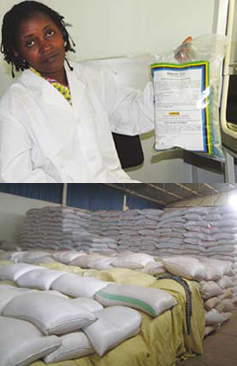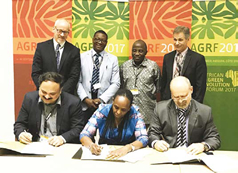EAC Policymakers Trained on Aflatoxins and their Effective Antidote, Aflasafe
“Aflatoxin is a silent killer and a major health problem all over the world. It has no smell, taste, or color, therefore millions of people in Africa including infants and children, are exposed to the poison without their knowledge."
 A week-long training for policymakers from the East Africa Community (EAC) partner states on aflatoxins and progress on efforts to reduce its contamination in food and feeds in the region was done in Dar es Salaam, Tanzania.
A week-long training for policymakers from the East Africa Community (EAC) partner states on aflatoxins and progress on efforts to reduce its contamination in food and feeds in the region was done in Dar es Salaam, Tanzania.
The training was part of ongoing efforts by the EAC Secretariat in partnership with the Africa Union (AU), USAID, and the International Institute of Tropical Agriculture (IITA), among many other partners, to prevent and control aflatoxin contamination, a major threat to food security in the region, a health hazard, and which affects trade in food and agricultural commodities. The training was conducted at and by IITA experts.
East Africa is a hotspot for aflatoxins—highly poisonous chemicals produced by the mold Aspergillus flavus which is found in soils. They affect both humans and animals that eat contaminated food and feed, and can cause liver disease (including cancer) and lower the body’s immunity. In children, aflatoxins impair growth leading to stunting. Acute exposure can lead to instant death.
The aflatoxin-producing molds affect many crops but the key staples of maize and groundnut are the most susceptible. Aflatoxin contamination also affects trade as grains that have high levels of the toxins cannot be exported and must be destroyed—at a cost. “The multi-sectoral impacts and effects of aflatoxin constitute a significant challenge to agriculture, health, and trade. It is one of the challenges undermining the desired levels of social and economic transformation and regional integration in the East Africa Community,” said Fahari Marwa, a Principal Agricultural Economist at the EAC Secretariat.
“The EAC has been spearheading interventions aimed at addressing the incidences and impact of aflatoxins to enhance food utilization, nutrition, and food safety. The secretariat has developed the EAC Aflatoxin Prevention and Control Strategy which was approved at the 10th Sectoral Council on Agriculture and Food Security.
The training also focuses on strategies for preventing and controlling aflatoxin contamination including looking at the progress in developing and rolling out aflasafe—one of the technologies that has proven effective in reducing contamination—across the five EAC countries.
Aflasafe was developed by IITA in collaboration with the United States Department of Agriculture– Agricultural Research Service (USDAARS) and other local and international partners. Aflasafe is made up of the mold of the same family as the type that produces aflatoxins but which do not produce the toxin and can displace their toxin-producing relatives from the soil. Aflasafe has been able to consistently reduce aflatoxin contamination in crops by over 80% in trials across the continent.
“Aflatoxin is a silent killer and a major health problem all over the world. It has no smell, taste, or color, therefore millions of people in Africa including infants and children, are exposed to the poison without their knowledge. Testing in the laboratories is the only sure way to know if aflatoxin is present in the food and feed but this is very expensive. Therefore, reducing the mold that produces aflatoxins is one of the effective ways to reduce the contamination,” said Dr Victor Manyong, IITA Director for Eastern Africa while also speaking at the training’s opening session.
 “Aflasafe is a very cost effective and efficient technology in reducing aflatoxin contamination in food and feed. Together with our partners we are working with many countries all over Africa to develop their own product using locally sourced strains of the non-toxic mold. We have developed local products for over 10 countries in Africa,” he said.
“Aflasafe is a very cost effective and efficient technology in reducing aflatoxin contamination in food and feed. Together with our partners we are working with many countries all over Africa to develop their own product using locally sourced strains of the non-toxic mold. We have developed local products for over 10 countries in Africa,” he said.
In East Africa, Kenya is at an advanced stage as AflasafeKE has been registered in the country through a partnership between IITA and the Kenya Agriculture Livestock Research Organization (KALRO) and the construction of a plant to manufacture it locally is almost complete.
In Tanzania, the Ministry of Agriculture, Livestock and Fisheries and IITA have developed their local product AflasafeTZ and put together the dossier for its registration. In Burundi, Rwanda, and Uganda, the development of their local product is ongoing.
“Aflatoxins are often looked at as a postharvest issue while in fact they are a preharvest problem. This is because contamination takes place while the crops are still in the field. The fungi then continue to produce aflatoxins during postharvest handling and storage. Therefore, preharvest management is a very critical stage for preventing and reducing contamination of crops while in the field as this will reduce contamination during storage,” said George Mahuku, IITA plant pathologist, and one of the trainers.
“Good postharvest and storage management of the aflatoxin-free produce is also important to reduce the risk of further contamination. These include not spreading the produce on bare soils to dry, ensuring they are dried properly to a safe moisture content of 12% or below, and use of clean and dry storage that will keep away moisture and pests,” he added.
The training enabled policymakers to get a better understanding of the aflatoxin problem and the biocontrol technology, Aflasafe. The training also covered efficacy of the aflasafe technology and its benefits, and how it is produced. Policymakers also reviewed the status and the progress made in the transfer and application of aflasafe technology in the EAC Partner States and discuss sustainable models and identify strategic pathways for upscaling and out scaling of aflasafe in the EAC.
Catherine Njuguna, IITA Eastern Africa,
This email address is being protected from spambots. You need JavaScript enabled to view it., +255 767 361 255